By Ted Katauskas
Years before pandemic lockdowns and quarantines normalized teleworking and transformed homes from primary residences into ersatz places of business— stimulating a nationwide run on real estate that ignited bidding wars in virtually every zip code—the
City of Ellensburg had identified a dearth of available housing as a linchpin issue that would either make or break the community’s future. Nestled on the banks of the Yakima River in the heart of mountainous Kittitas County, Ellensburg has
long embraced its heritage as an oasis in the wilderness with an up-by-the-bootstraps ethos.
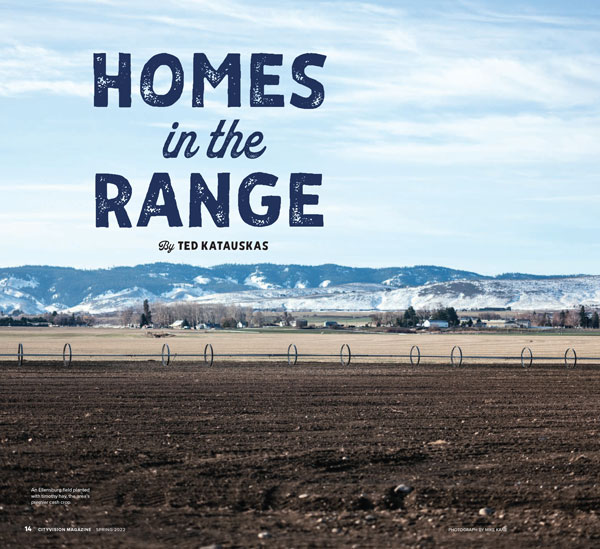
Having hosted the 1889 State Admission Convention six years after its incorporation, the Northern Pacific whistle stop some were calling the “Pittsburgh of the West” was so certain it would become the seat of state government that it had begun
clearing a site (dubbed Capitol Hill) when a fire swept through town and scuttled its bid. Instead, the Legislature designated Ellensburg as home of the State Normal School. More than a century later, Central Washington University remains Ellensburg’s
largest employer, with more than 1,400 on its payroll, and boasts a student enrollment of more than 11,000 that counts as more than half of the city’s population and skews its demographics younger (median age: 23). After the university, the
community hospital, the school district, and county government, Anderson Hay and Grain, with a workforce of 240, is Ellensburg’s largest employer, dedicated to the Kittitas Valley’s signature crop: timothy hay, a dietary staple of thoroughbred
racehorses and premium Kobe beef cattle that’s shipped to markets as far away as Saudi Arabia and Japan, generating an annual windfall of $80 million. The percentage that trickles down to local wages, though, has by far been eclipsed by a runaway
real estate market.
“As far as the housing crunch goes, we are definitely not alone,” says Ellensburg Planning Manager Jamey Ayling. “But we are a little bit unique in the fact that we are a college town, which contributes considerably to some of our housing
prob- lems. When three or four or five college students go and rent out a single-family home, it takes that home off the market for a family. It’s crazy what people will pay for a house because there’s just nothing available, and the pricing’s
a little bit obnoxious.”
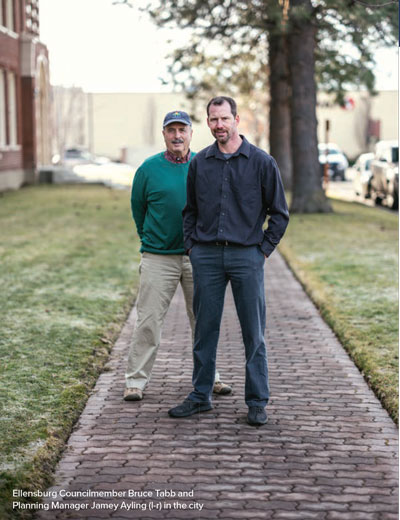
How obnoxious?
At press time, according to Zillow.com, the median price for a single-family home in Ellensburg was $445,212, a 30 percent increase from 2021 and a 40 percent increase from 2019. Meanwhile, the site listed just three one-bedroom apartments available for
rent in the entire city. The median one-bedroom apartment rental cost ($1,600/month or $19,200/year) represents 48 percent of the median household income ($39,645 annually, a bit more than half the statewide median of $73,775), which far exceeds the
federal threshold of being deemed “cost burdened” at 30 percent. For families searching for larger accommodations, Zillow.com listed just three three-bedroom homes for rent in the city, with a median monthly rate of $2,400, or $28,800
annually, representing 72 percent of the local median household income. With 68 percent of all households renting—and the average rent increasing by 24 percent over the past decade, outpacing income growth by 9 percent—almost half of Ellensburg’s
population has been deemed cost burdened or severely cost burdened (spending more than 50 percent of household income on housing).
This phenomenon predates the pandemic by decades. Locals still talk about the 1980s and 1990s, when university students unable to find housing on campus resorted to camping along the Yakima River. That spurred CWU and local developers to build dormitories
and apartments near campus, in addition to more single-family homes, but demand continued to outpace supply. More recently as Seattle real estate boomed, tech workers and young families priced out of that market began buying homes in Ellensburg, further
ratcheting up prices.
“Over the past five to seven years, the affordability of Seattle has driven Seattleites to Ellensburg because our median home sales price was still a bargain relative to the Seattle market,” says councilmember and former mayor Bruce Tabb,
who notes that the Emerald City is just a 90-minute drive away, hardly a stretch for a King County commuter who spends as much time idling in I-5 rush hour traffic every day. Couple that with 300-plus days of sunshine that Ellensburg enjoys on the
dry side of the Cascades and the town’s Mayberry-like appeal, and for many, relocating is a no-brainer.
“You’re looking at a community with an incredibly vibrant downtown,” adds Tabb. “We’ve never had outward sprawl, so there’s no malls or strip malls. We’ve still got neighborhoods and a sense of connectedness and
a decent school system and, in terms of starting a family, you can get more home here than you could in that big metro.”
Kelle Dvorak Vandenberg, who graduated from CWU in 1999 and married a longtime local, moved back to Ellensburg from Woodinville in 2019 after a 15-year stint in marketing and custom packaging at global behemoth TricorBraun.
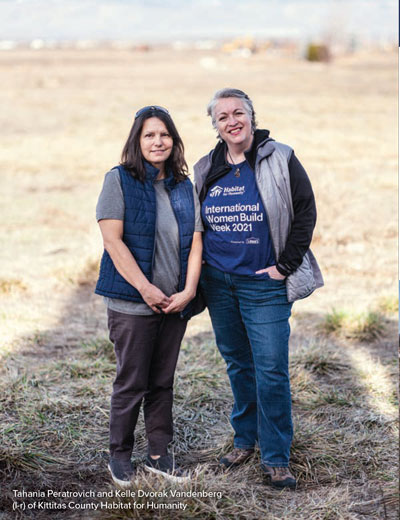
“There’s a magic to it,” says Vandenberg, now the area director of Kittitas County Habitat for Humanity. “It’s hard for the westside and Seattle to compete with all of the life amenities in Kittitas County. It’s this
quiet, sequestered town in this beautiful valley with rivers and lakes and mountains and some of the best fly-fishing in the country. It’s a wonderful quality of life. However, it can be challenging to make a living wage here. While the valley
has some industry, such as agricultural, we lack manufacturing or technology jobs in the region. Many of our employers are smaller retail or restaurants that rely on tourism and local purchasing.”
By November 2017, Ellensburg’s housing crisis had become so acute that the city sponsored and voters passed Proposition 1, a 0.1 percent local sales tax to fund affordable housing initiatives. A few months later, apartment vacancy rates in Kittitas
County dipped below 0.7 percent, the lowest in the state, and the inven- tory of available owner-occupied homes also evaporated, with only five active listings under $300,000 on the Northwest Multiple Listing Service—and none less than $250,000,
prompting the local paper to publish an editorial urging city leaders to take action.
“There are core elements we finance as a community—police, fire, health services (hospital) and schools, but there is nothing more basic than housing,” opined The Daily Record in April 2018. “The catch is housing primarily
is a private sector function, which is influenced and in some cases limited by public sector decisions…We will have a better perspective on this five or 10 years down the road, but it feels like we’re in the midst of a tran- sition period
where the decisions we make will greatly influence the communities we call home.”
In May 2018, Ellensburg’s council passed Ordinance 4799, creating a seven-member Affordable Housing Commission, led by Bruce Tabb, tasked with administering its Affordable Housing Fund (which typically yields $560,000 a year in revenue) and “making
recommendations to city council for addressing the identified affordable housing needs of city residents.” With a $50,000 Department of Commerce grant funded by the state Legislature in May 2019, the city retained Seattle-based BERK Consulting
to help it create a Housing Action Plan, a voluminous 140-page document the council adopted in October 2021.
“The reality is,” explains Tabb, “we needed a plan.”
The first step in devising that plan was to quantify the problem by creating a housing needs assessment, which BERK accomplished by assembling and analyzing reams of data from a plethora of sources, including the US Census Bureau, the US Department of
Housing & Urban Development, and the Washington Office of Financial Management. After crunching the numbers, in addition to preparing its written report BERK built a microsite linked to the city’s website, a tool with pie charts and bar
graphs to educate anyone who wants to understand, and potentially help solve, the problem, from home builders and real estate professionals to city planners, nonprofit partners, and interested residents.
Scrolling through numbers on the interactive site tells a story that’s much more nuanced than might be expected. Currently, Ellensburg adds just 107 units of new housing each year, yet in order to address its undersupply and meet population growth
targets, the city will need to produce as many as 333 new units annually until 2037. Compounding this problem, Ellensburg’s existing housing inventory represents a fundamental mismatch with its population: although 70 percent of households have
one or two members, only 25 percent of all housing units are studios or one-bedrooms; and while three-member households make up only 18 percent of the population, three-bedroom housing is the norm, at 37 percent of the total. Then there’s the
affordability factor: to be able to make rent without being cost burdened, an Ellensburg apartment dweller needs to earn $55,200 a year; a homeowner will need a salary of $64,079 to afford a bottom-tier home, well above the average median income.
We’ve still got neighborhoods and a sense of connectedness and a decent school system and, in terms of starting a family, you can get more home here than you could in that big metro.
– Bruce Tabb, Ellensburg councilmember
So in addition to more than doubling the rate of production and diversifying the types of homes being built—the Housing Action Plan’s top goal—Ellensburg also needs to find ways to make the homes it creates affordable to rent or own.
Which is where the second step of the plan comes into play: policy review.
“One of the major takeaways for me from the plan was that there are clearly things that the city council can do, working with our staff, to change our code to create a more encouraging environment for building the types of housing that are needed
to begin to address these problems,” says Tabb. “What will it take, or what does the city have in place, to encourage the type of housing that creates what’s called the ‘missing middle’—for the folks who aren’t
looking for a half-million-dollar house but a $225,000 or a $175,000 house, or they’re looking for rentals that are going to fall into that affordable range so that they’re not cost burdened?”
According to the plan, that means amending zoning codes and permitting requirements to allow and incentivize the production of “missing middle” homes, including accessory dwelling units (ADUs), town homes, multiplex developments, and condo-
miniums, as well as “cottage housing,” small residential units for multiple families clustered around shared common space on lots normally reserved for detached single-family homes. BERK’s “flexible toolbox to address Ellensburg’s
housing needs” also included rezoning commercial districts to allow for mixed-use residential development, increasing building heights and changing density limits, preserving income-restricted afford- able housing developments, and incentivizing
or partnering with developers to build new affordable housing developments. Although Ellensburg had amended its code in 2013 to allow for the construction of ADUs and cottage housing, the city had only permitted four ADUs per year, compared to 53
single-family units; to reduce barriers for interested homeowners, BERK recommended developing a “how-to” brochure and working with local architects to develop preapproved plans.
In addition to public hearings, the city employed a website (beheardeburg.com) to serve as a pandemic-friendly public engagement platform on the initiative, polling residents about preferred housing types and eliciting feedback about proposed
zoning changes. The site attracted more than 850 visitors, including 230 who completed a detailed visual preference survey with computer-generated renderings of neighborhoods populated with infill projects. The city also convened a Housing Action
Plan Stakeholder Advisory Group, a dozen leaders from the community including developers, contractors, real estate agents, representatives from the university, and local nonprofits, which met three times to workshop and provide feedback on potential
housing strategies.
“The community involvement piece was huge,” says Ayling, the city’s planning manager. “We tried specifically to go to people that we weren’t used to working with rather than going with the same four people who volunteer for
everything, and that was eye-opening…There’s this assumption that everybody in Ellensburg wants to have a large lot with one home on it because it’s farm-style living in this neck of the woods, but that’s not really the case.”
Just ask Tahania Peratrovich. In 2009, after her marriage ended in a divorce, Peratrovich was living in an 800-square-foot converted garage she shared with three young daughters and rented for $550 a month, a space so small that sitting on the toilet
required her to dangle her feet in the bathtub. Then she won the lottery, or the equivalent, when her application to buy a Habitat for Humanity home was accepted. After putting in 500 hours of sweat equity, Peratrovich moved into a brand-new, 1,100-square-foot,
1.5-bathroom home on July 1, 2010. Her $745 monthly mortgage payment is a bargain compared to the $1,200 another tenant is paying to rent that cramped garage apartment unit today.
“Having a home base helped so much,” says Peratrovich, who now works as the home repair superintendent at Kittitas County Habitat for Humanity (KCHH). “It just turned our life back around.”
Now, Peratrovich is looking forward to paying her good fortune forward by donating labor to the next Habitat families who will begin building homes this spring at Stuart Meadows, a $4.7 million, high-density affordable housing community the nonprofit
is developing on a three-acre parcel on the north side of town. Not only did the city donate the land, but it also seeded the project with $765,000 from its Affordable Housing Fund, Ellensburg’s first major disbursement.
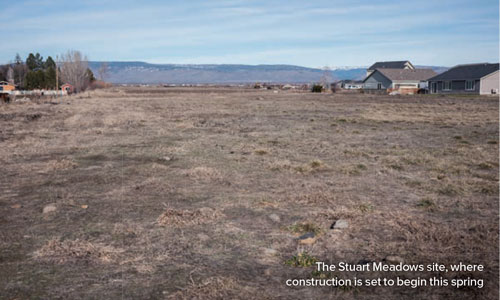
Using the land trust model—which takes the cost of land out of the home-buying equation and keeps prices low—the nonprofit holds the land in a 99-year trust and leases it back to the local homeowners association; homeowners agree to a capped
appre- ciation rate and to resell only to KCHH or another qualified low-income buyer. At Stuart Meadows, three of the homes (each 1,150 square feet with three bedrooms and 1.5 bathrooms) will be reserved for families with household incomes at 60 percent
of the average median income or less, with the balance reserved for families with household incomes of 80 percent AMI; after they have donated at least 20 hours of sweat equity per week to the build, monthly housing costs for owners at Stuart Meadows
will vary between $850 and $1,440 a month depending on income and interest rates. That’s far less than the median rent or a market- rate mortgage on a similarly sized new home in Ellensburg.
“I really give hats off to the City of Ellensburg for the having the vision to understand that the community as a whole would get behind this revolutionary idea of using sales tax money to help fund affordable housing,” says KCHH’s Vandenberg.
“When you have a municipality that believes that change needs to happen, that affordable housing has to come into the community, and they do something about it . . . for me, that was wonderful to see.”
“There are people within the community that need this win,” she adds, noting that the nonprofit currently has about 125 potential homeowners on its waiting list. “They need to see that not only is the city doing something about affordable
housing, which they absolutely are, but this is the first of many projects.”
On the other end of town on South Pearl Street, another local nonprofit, HopeSource, plans to break ground this spring on Addison Place, five studio apartments for seniors and people with disabilities, a $1 million project that’s being bankrolled
with grants from the county, a private donor, and more than
$300,000 from the city’s Affordable Housing Fund.
Since 2003, in partnership with the city, county, and private developers, HopeSource has built more than 600 units of affordable housing in Kittitas and two neighboring counties. The most recent was Spurling Court, a 49-unit complex of one- and two-bedroom
apartments and town homes in Ellensburg, half available for those classified as homeless, that was completed in June and financed with low-income housing tax credits, $500,000 from county afford- able housing and homelessness funds, and a deferred
federal loan; the City of Ellensburg also waived impact fees to reduce costs.
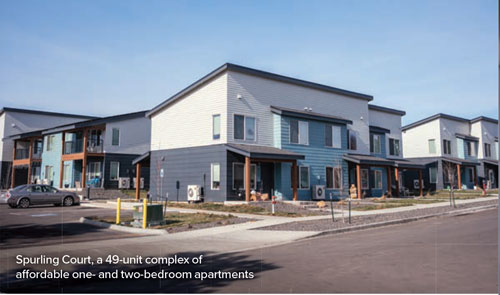
“The city has been a great partner, and they’ve been really focused on helping with zoning and covenant restrictions,” says HopeSource Chief Operations Officer John Raymond. “You’re not going to build your way out this, but
you can certainly make progress if you’ve got willing partners who each can come to the table with what they can contribute.”
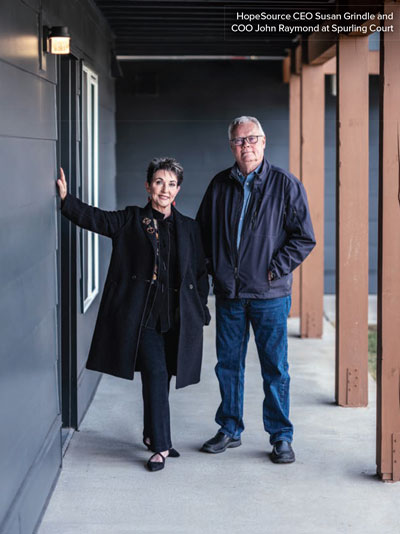
That progress includes collaborations with developers like Matthew Stalder, who by the end of the year plans to break ground on 57 units of studio and one-bedroom housing for low-income tenants on a lot the city donated (valued at $158,000, just around
the corner from HopeSource’s Addison Place) that had been used as a community garden.
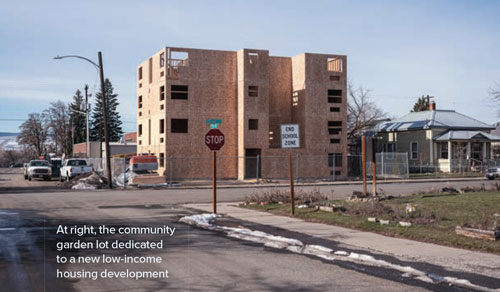
“I’m helping alleviate the supply part of what’s causing this,” Stalder says, noting that the city made the project feasible by donating the land, which is increasingly difficult to find.
We’re trying to stay in from of this as much as we can, trying to come up with good cures that will retain our small-town charm.
– Jamey Ayling, Ellensburg Planning Manager
Since Ellensburg has yet to permit a single cottage housing project, it’s hoping to find a partner to build a cottage housing pilot/ demonstration project and create a set of preapproved stan- dardized blueprints that developers like Stalder can
use to easily replicate the model. Through rezoning, the city hopes to stimulate redevelopment of a long-vacant motel into an affordable housing apartment complex and catalyze business growth in underdeveloped commercial tracts with the addition of
mixed-use affordable housing complexes. Also on the table: tapping into its Affordable Housing Fund to incentivize devel- opers to factor affordability into new construction, say by paying $400,000 to a developer who plans to build a $1 million apart-
ment complex to reserve four of 10 units for low-income tenants, to be rented at HUD-approved rates for a period of 25 years.
“It’s a win from the developer’s standpoint because they’re borrowing $600,000 at 7 percent instead of a million dollars,” explains Tabb. “And it’s a win for the individuals living in those apartments, and it’s
a win for us because we’re creating afford- able housing capacity that otherwise wouldn’t exist.”
“We’re trying to be proactive,” adds Ayling. “We’ve put a lot of things in place ahead of time: our affordable housing tax that we can tap into, looking at these zoning codes already by having a Housing Action Plan. We’re
trying to stay in front of this as much as we can, trying to come up with good cures that will retain our small-town charm.”
He’s hoping more remedies will arrive in June 2023, when the city is scheduled to complete a Housing Action Plan imple- mentation plan funded with a $75,000 grant from the state Department of Commerce.
But in so many ways, it’s a work already in progress.